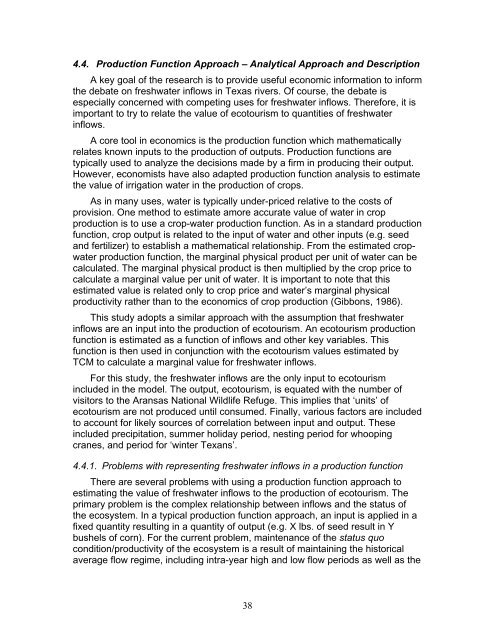The Economic Value of Water and Ecosystem Preservation
The Economic Value of Water and Ecosystem Preservation
The Economic Value of Water and Ecosystem Preservation
You also want an ePaper? Increase the reach of your titles
YUMPU automatically turns print PDFs into web optimized ePapers that Google loves.
4.4. Production Function Approach – Analytical Approach <strong>and</strong> Description<br />
A key goal <strong>of</strong> the research is to provide useful economic information to inform<br />
the debate on freshwater inflows in Texas rivers. Of course, the debate is<br />
especially concerned with competing uses for freshwater inflows. <strong>The</strong>refore, it is<br />
important to try to relate the value <strong>of</strong> ecotourism to quantities <strong>of</strong> freshwater<br />
inflows.<br />
A core tool in economics is the production function which mathematically<br />
relates known inputs to the production <strong>of</strong> outputs. Production functions are<br />
typically used to analyze the decisions made by a firm in producing their output.<br />
However, economists have also adapted production function analysis to estimate<br />
the value <strong>of</strong> irrigation water in the production <strong>of</strong> crops.<br />
As in many uses, water is typically under-priced relative to the costs <strong>of</strong><br />
provision. One method to estimate amore accurate value <strong>of</strong> water in crop<br />
production is to use a crop-water production function. As in a st<strong>and</strong>ard production<br />
function, crop output is related to the input <strong>of</strong> water <strong>and</strong> other inputs (e.g. seed<br />
<strong>and</strong> fertilizer) to establish a mathematical relationship. From the estimated cropwater<br />
production function, the marginal physical product per unit <strong>of</strong> water can be<br />
calculated. <strong>The</strong> marginal physical product is then multiplied by the crop price to<br />
calculate a marginal value per unit <strong>of</strong> water. It is important to note that this<br />
estimated value is related only to crop price <strong>and</strong> water’s marginal physical<br />
productivity rather than to the economics <strong>of</strong> crop production (Gibbons, 1986).<br />
This study adopts a similar approach with the assumption that freshwater<br />
inflows are an input into the production <strong>of</strong> ecotourism. An ecotourism production<br />
function is estimated as a function <strong>of</strong> inflows <strong>and</strong> other key variables. This<br />
function is then used in conjunction with the ecotourism values estimated by<br />
TCM to calculate a marginal value for freshwater inflows.<br />
For this study, the freshwater inflows are the only input to ecotourism<br />
included in the model. <strong>The</strong> output, ecotourism, is equated with the number <strong>of</strong><br />
visitors to the Aransas National Wildlife Refuge. This implies that ‘units’ <strong>of</strong><br />
ecotourism are not produced until consumed. Finally, various factors are included<br />
to account for likely sources <strong>of</strong> correlation between input <strong>and</strong> output. <strong>The</strong>se<br />
included precipitation, summer holiday period, nesting period for whooping<br />
cranes, <strong>and</strong> period for ‘winter Texans’.<br />
4.4.1. Problems with representing freshwater inflows in a production function<br />
<strong>The</strong>re are several problems with using a production function approach to<br />
estimating the value <strong>of</strong> freshwater inflows to the production <strong>of</strong> ecotourism. <strong>The</strong><br />
primary problem is the complex relationship between inflows <strong>and</strong> the status <strong>of</strong><br />
the ecosystem. In a typical production function approach, an input is applied in a<br />
fixed quantity resulting in a quantity <strong>of</strong> output (e.g. X lbs. <strong>of</strong> seed result in Y<br />
bushels <strong>of</strong> corn). For the current problem, maintenance <strong>of</strong> the status quo<br />
condition/productivity <strong>of</strong> the ecosystem is a result <strong>of</strong> maintaining the historical<br />
average flow regime, including intra-year high <strong>and</strong> low flow periods as well as the<br />
38
















